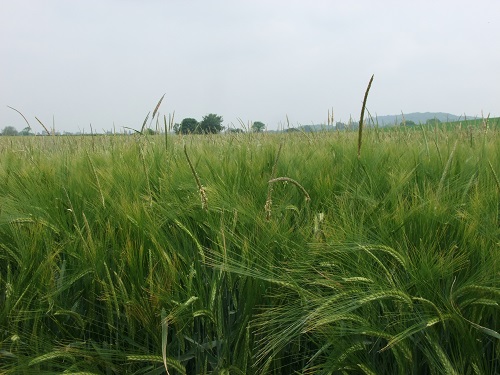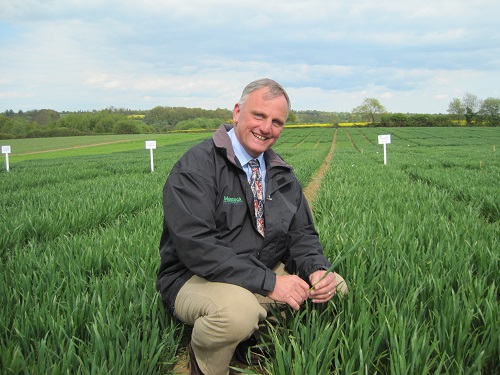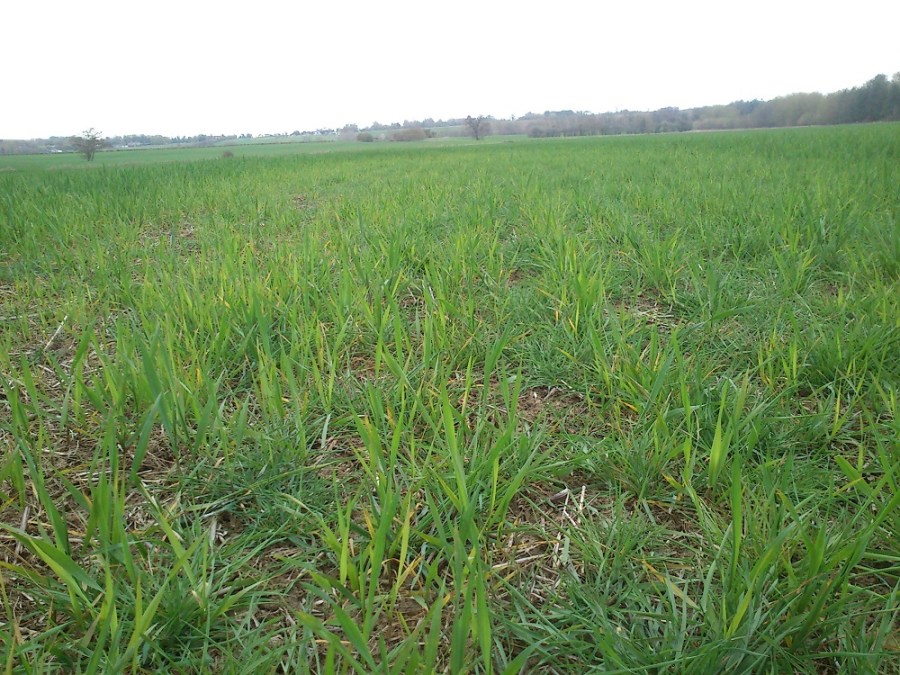Tailoring a strategy for blackgrass control to suit each field is fundamental to five strategies for five years. CPM looks at how you can use competition to your advantage.
Varieties which are slow moving in early spring are less competitive with blackgrass.
By Lucy de la Pasture
When it comes to blackgrass control, every little bit helps. Competition between the crop and weeds is a two-way process, but tipping the balance in favour of the crop will help suppress blackgrass, says Dr Stephen Moss. The big question is how much can you do to help influence this?
“Some things, such as soil moisture, are in the lap of the gods but there are tweaks that can stack the odds in favour of the crop when it comes to competitiveness.”

Six row and Hyvido barley varieties are more competitive than two-row barley, which is more competitive than winter wheat.
Selecting the right crop is a good starting point, he suggests, with some crops known to be more competitive than others.
“Spring barley is twice as competitive as spring wheat when sown at the same density. It’s a well-established fact that winter barley can be suppressive of blackgrass and the hybrid six-row barleys have a superior competitive effect to conventional two-row types,” he notes.
Agrii’s Colin Lloyd agrees barley is inherently more competitive than winter wheat. Results from a blackgrass crop competition trial at Stow Longa in 2015 back this up, with the average yield of winter wheat at 5.3t/ha compared with a winter barley yield of 10.1 t/ha, when plots were drilled on 1 Oct with a high background infestation of blackgrass.
“A move to drilling later in Oct boosted winter wheat yields to 9.4t/ha, as a consequence of reduced blackgrass competition, and winter barley yields reduced as you’d expect in the later drilled slot,” he adds.

Colin Lloyd says that more competitive varieties are best if you have to start drilling earlier than mid-Oct in a blackgrass situation.
Syngenta’s Dr Jonathan Ronksley claims a competitive edge for Hyvido varieties, but clarifies they compete with blackgrass in a way that’s unique to the hybrid and is due to its vigorous growth habit.
“Independent trials carried out by ADAS in 2015, showed levels of blackgrass seed return significantly less (68%) than in conventional winter barley and 85% less than in winter wheat, a Hyvido effect that has been consistently seen the past three seasons,” he says.
According to Jonathan, the competitive effect of the Hyvido kicks-in in the spring. “The hybrid vigour of the Hyvido gives increased tillering in the spring and this is when the crop begins to have a suppressive effect on blackgrass, from both above and below ground,” he explains.
According to Syngenta trials, Hyvido barleys produce a root mass that’s much larger than in a conventional barley. This enables the crop to outcompete blackgrass plants for water and nutrients. Above ground, the main competitive element of Hyvido comes into play between GS39-59, Jonathan explains.
“A Hyvido flag leaf is 55% larger than a conventional flag and the crop has larger ears. The shading effect of the tall canopy causes the blackgrass sitting beneath it to struggle, resulting in smaller blackgrass plants with fewer tillers and smaller, less mature seed heads.”
And it’s this competitive effect that accounts for the extent of the reduction in seed return seen in trials, he believes.
Colin has questioned whether the competitive effects of Hyvido are due to hybrid vigour or the influence of the six-row barley it was derived from.
“We’ve found conventional six-row barleys to be as competitive as a hybrid but they can’t compete on yield quality, tending to have much poorer specific weights,” he says.
Stephen also doubts that the competitive effect of Hyvido is due to hybrid vigour alone, recalling research he carried in the 1970s which showed six-row barley to be much more competitive to two-rows.
“Looking at the AHDB Recommended List, the one conventional six-row variety (Funky) yields more than Volume and almost as much as the other hybrids. If hybrids have a much larger root mass and massive leaves I would expect more than a few % yield increase. Hybrids are sown at lower seed rates which means they have more space for tillering – as would any variety and this would also lead to a bigger root mass per plant,” he comments.
Colin’s been conducting fully replicated randomised trials on different varieties and cereal crop species since 2004.
“The crop competition work at Stow Longa was born out of observations when field walking that some varieties seemed to have less blackgrass in them than others. As an agronomist, I wanted to know whether this was a coincidence or whether there was a variety effect going on,” he explains.
Early work concentrated on three varieties popular at the time – Robigus, Hereward and Gladiator. Paired plots, one untreated and the other with a full herbicide programme, were set up to give an insight on the ability of the variety to suppress blackgrass without the help of a herbicide.
Significant differences were reported between the varieties in a scientific paper published in 2007, with Hereward proving to be the least competitive of the bunch. The competition trial has now expanded to include 28 varieties of winter wheat, including some which are coded, and five barley varieties.
“The important fact we’ve learned is that the varieties which are slow moving in early spring are less competitive with blackgrass, even if they tiller well.”
Colin cites Group 4 feed wheat Graham as a prime example. “It’s a variety that’s suitable for the early drilling slot. But if you need to start planting something before mid-Oct in a blackgrass situation, Graham is one of the least competitive varieties because it moves slowly in the spring.
“Conversely Dunston ranks highly on the competitive front as an earlier drilled variety (last week Sept-first week Oct), and will out-yield Graham in this slot in a blackgrass situation,” he explains.
Delayed drilling is one of the tactics that can be employed to reduce blackgrass populations but Colin points out that growers with a large acreage often need to start earlier than is ideal.
“Knowing the competitiveness of a cereal species or variety is important so it can be planted in the right spot. If you’re drilling on the early side, use a competitive variety or species, such as barley, but as drilling date gets later, variety becomes much less influential on blackgrass populations. Prioritise the worst blackgrass fields and drill these late or in the spring,” he advises.
Colin also notes when looking at the competitiveness of different cereal species, there’s a distinct pecking order.
“Winter wheat is less competitive than winter barley but spring crops are more competitive than any of the autumn sown cereals. Of the spring species, oats are the most competitive and wheat the least.”
Making sure spring crops are planted with minimal soil disturbance into soil that was prepared during the previous autumn is also key to reducing blackgrass populations in the spring, he adds.
For conventional varieties of barley and wheat, higher seed rates are needed to increase their ability to suppress blackgrass, continues Stephen.
“The pendulum has swung from the vogue of using low seed rates back to employing higher seed rates. There’s good data supporting the change but later sowings will be using increased seed rates anyway. But how high can you go?”
The answer probably lies in local knowledge, he believes. “Certain varieties and fields are generally more prone to lodging, so this is something to weigh up when deciding on seed rate.
“At above 500 seeds/m2 it’s probably a case of diminishing returns but it depends on establishment and this is a factor that’s often over-estimated. On average winter wheat establishment is 67% but most growers would reckon theirs is higher than this.
“Establishment rates tend to decline as seed rates become higher, highlighting the fact that the benefit becomes less as rates increase. So there are limits to seed rate,” he reasons.
Stephen struggles with the concept of using small differences in variable seed rates as a means of combatting blackgrass problems.
“The difference required in seed rate to make a difference in seed return is substantial, not a small tweak. According to trial results, comparing winter wheat seed rates of 150 seed/m2 and 450 seeds/m2, there’s a 60% reduction in blackgrass seed return at the higher seed rate. But it’s a threefold increase in seed rate that’s needed to have this effect,” he comments.
For Hyvido barley the seed rate ceiling is substantially lower than for conventional crops, explains Jonathan.
“Trials at ADAS Boxworth in 2016 investigated the effect of using higher seed rates on blackgrass suppression. As a result, the recommendation for Hyvido remains at 200-250 seeds/m2.
“Seed rates up to 250 seeds/m2 gave excellent blackgrass suppression. At higher seed rates, Hyvido starts to compete with itself, limiting tillering and causing a deterioration in grain quality,” he says.
Avoiding wide row spacings is another way of influencing a crop’s competitiveness, adds Stephen.
“In studies of row width, there were 18-23% fewer weed heads/plant in wheat sown at narrow 6cm spacing, and 20-39% more at a wide 24cm spacing when compared with a 12cm spacing.” However, he acknowledges that very narrow row spacing is impractical where straw and trash are an issue.
In an AHDB-funded project the effects of the two main cultural controls for blackgrass, delayed drilling and seed rates, were investigated in a partnership between Rothamsted and NIAB-TAG.
The project ran over several years with five fully-replicated trials looking at three different winter wheat seed rates – 175 seeds/m2, 350 seeds/m2 and 525 seeds/m2, explains Rothamsted weed scientist, Richard Hull.
“We found that seed rate made no significant difference to the number of blackgrass plants that emerged, but at a seed rate of 350 seeds/m2 there was a 5% reduction in the number of blackgrass heads, compared with the lowest seed rate used. At the 525 seeds/m2 there was a reduction of 29% in the number of seed heads.”
At higher seed rates, the size of blackgrass seed heads and the number of seeds within them was also reduced but not significantly, he notes.
“The biggest crop competition effect is when the crop starts tillering in the spring. The density of the crop in the autumn won’t affect the amount of blackgrass that germinates but will reduce the number of blackgrass heads in the spring.”
One of Stephen’s bugbears is that blackgrass is often referred to as a marsh-loving weed. It isn’t, he explains.
“You simply don’t get blackgrass in marshes – unless they have been drained for arable use. It likes wet conditions but isn’t a marsh weed and doesn’t like to be waterlogged. Where land has good drainage, blackgrass is much easier to deal with because it produces better crops which helps tip the balance in favour of the crop over the blackgrass.”
One of the many properties attributed to cover crops is an improvement in soil structure which can help the infiltration of water through the soil profile.
“There’s a lot of mumbo-jumbo associated with cover crops but they have the potential to offer lots of value in blackgrass situations, in an indirect way,” believes Stephen.
Agrovista’s Stewart Woodhead agrees, adding that cover crop is a misnomer and should really be called a trap-crop where blackgrass is concerned.
“In our view, a cover crop isn’t there to out-compete blackgrass. The last thing we want is to shift the germination of the weed to the spring by selecting for spring-germinating types of blackgrass. The aim of an autumn cover crop is to trick the blackgrass into germinating by planting into shallow cultivated soil, where only the top 5cm has been disturbed,” he says.
Stewart believes the best cover crop in a blackgrass situation is one with a low biomass in the autumn and drilled at a low seed rate, so that there’s plenty of space for the blackgrass to emerge. The initial concept behind planting a cover crop was to reliably enable spring drilling on heavy land because a spring crop is more able to reduce blackgrass populations, he explains.
“The cover crop biomass helps remove water from the soil while binding the soil together, meaning soils can be worked earlier in the spring. Where fields have been left over-winter as a stale seedbed, soils are normally dry on the top but wet underneath. For cover crops, this is often the other way around but there’s still an improvement in the earliness the soil becomes workable,” he explains.
At Lamport, Agrovista’s heavy-land blackgrass site in Northants, four year’s work on cover crops and companion crops has shown some promising results in a background blackgrass population of over 2000heads/m2.
“A cover cop followed by spring wheat has given at least 98% control for the past three years. It’s important not to look at any one year in isolation when it comes to blackgrass, different strategies and types of cover crop will be appropriate for different fields in different years.
“Spring wheat following black oats and vetch has consistently performed well at Lamport. The project was originally intended to be a five-year project but it’s been extended because five years won’t be long enough to bring blackgrass back down to manageable levels,” he says.
Stewart believes that there’s been far too much reliance on chemistry to solve the blackgrass problem and it should be considered as a last resort.
“We need a change of mindset and cultural strategies in place even before blackgrass becomes a substantial problem on the farm. On top of that, attention to detail is most important. When direct drilling into a cover crop, all the good work can be undone by drilling too fast and creating soil disturbance, enabling a new flush of blackgrass to come through,” he comments.
Stephen agrees, adding that cover crops aren’t a magic solution but part of a much bigger picture when it comes to influencing blackgrass populations.




